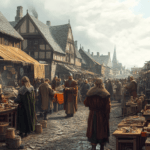
The Norse, often depicted as fierce raiders and warriors, are also celebrated for their remarkable transformation into skilled merchants and traders. This dual identity as both raiders and traders played a pivotal role in shaping medieval European commerce. By exploring the transition from feared invaders to respected traders, we can better understand their influence on the economic landscape of Europe during the Viking Age (circa 8th to 11th century).
The Viking Age: A Time of Expansion
The Viking Age began around 793 AD, marked by the infamous raid on the Lindisfarne monastery. This period was characterized by extensive exploration and expansion by Scandinavian seafarers from modern-day Norway, Sweden, and Denmark. Initially, the Vikings were known for their raids on coastal settlements across Europe, targeting monasteries and towns for their wealth. These raids were not only acts of plunder but also strategic moves to establish dominance and secure resources.
However, as they ventured further afield, the Norse discovered that trade could be as lucrative as raiding. Their superior shipbuilding skills allowed them to navigate vast distances, reaching as far as North America to the west and the Caspian Sea to the east. This mobility facilitated their transition from raiders to traders.

From Raiders to Traders: The Transformation
The transformation of the Norse from raiders to traders was driven by many factors:
Economic Necessity: As Viking raids became more frequent, European communities began fortifying their settlements and organizing defenses, making raids less profitable. Consequently, Vikings turned to trade as a more sustainable means of acquiring wealth.
Cultural Exchange: Through interactions with various cultures during their raids and explorations, the Norse gained exposure to new goods and ideas. This exchange encouraged them to engage in trade networks that spanned continents.
Political Alliances: Establishing trade relationships often required forging alliances with local rulers. These alliances provided mutual benefits – the Norse gained access to markets and resources, while local leaders secured protection and economic growth.
Technological Advancements: The development of advanced shipbuilding techniques allowed Norse traders to carry larger cargoes over longer distances. Their longships were not only fast but also capable of navigating both open seas and shallow rivers, making them ideal for trade expeditions.
Norse Trade Networks
Norse trade networks were extensive and sophisticated, connecting Scandinavia with regions across Europe, Asia, and even North America. Key trading centers emerged in places like Hedeby in Denmark, Birka in Sweden, and Kaupang in Norway. These emporia became bustling hubs where goods from distant lands were exchanged.

Major Trade Routes:
- Eastern Routes: the Norse traveled along the Volga and Dnieper Rivers, reaching Constantinople (modern-day Istanbul) and the Abbasid Caliphate in Baghdad. These routes facilitated the exchange of furs, slaves, amber, and other goods for silver dirhams and luxury items from the East.
- Western Routes: In Western Europe, the Norse established trade links with the British Isles, France, and Iberia. They traded goods such as textiles, wine, and metals in exchange for Scandinavian products like timber and iron.
- Northern Atlantic Routes: The discovery of Iceland and Greenland opened new avenues for trade across the North Atlantic. Norse settlements in these regions engaged in commerce with Native American tribes in North America.

Commodities Traded By The Norse
The range of commodities traded by the Norse was diverse:
- Furs: High-quality furs from Scandinavia were highly sought after in warmer climates. Sable, ermine, lynx pelts were among the most prized items traded with Eastern markets.
- Amber: Known as “Baltic gold,” amber was a valuable commodity exchanged for precious metals and exotic goods from Asia.
- Slaves: The slave trade was a significant aspect of Norse commerce. Captured during raids or acquired through trade, slaves were sold throughout Europe and into Islamic territories where demand was high. Dublin was a particularly important slave market.
- Silver: Silver coins from Arabic regions became a standard currency within Viking trade networks. These coins were often melted down into bullion or used directly in transactions.
- Exotic Goods: Silk from China, spices from India, and glassware from Byzantium found their way into Scandinavian markets through these extensive trade routes.

Impact on European Commerce
The Norse transformation into traders had profound effects on medieval European commerce.
Following the collapse of the Roman Empire, European economies suffered stagnation. Norse trade networks helped revitalize commerce by reintroducing coinage systems and facilitating long-distance exchanges that brought wealth back into circulation.
Through trade interactions with different cultures – Arabs in the East or Franks in Western Europe – the Norse contributed to cultural diffusion across regions. This exchange enriched societies with new technologies, art forms, languages, and religious practices.
The establishment of trading towns like Dublin or York led to increased urbanization as people settled around these commercial centers seeking economic opportunities. These towns became melting pots where diverse cultures coexisted peacefully under shared economic interests.

By controlling key trade routes or forming alliances through marriage or diplomacy with local rulers (such as King Charles III), the Norse gained political influence beyond their homelands which shaped geopolitical landscapes across Europe.
The legacy left behind by Norse merchants is one characterized not only by conquest but also collaboration – a testament to human adaptability amidst changing circumstances.




